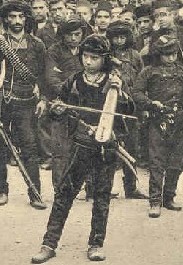Kemençe of the Black Sea
 | |
| String instrument | |
|---|---|
| Classification | stringed |
| Hornbostel–Sachs classification | 321.322 (Necked box lute) |
The Kemençe of the Black Sea (Turkish: Karadeniz kemençesi, Greek: Ποντιακή λύρα Pontiakí lýra or Pontic lyre, Laz: Çilili (ჭილილი), Armenian: քամանի Qamani) or Kemençe of Laz[1] is a bottle-shaped bowed lute found in the Black Sea region of Turkey (Pontus), adjacent Armenian and Georgian peopled lands, as well as in Greece. The name kemençe comes from the Iranian musical instrument, kamancheh (Persian: کمانچه).
Etymology
The name Kemençe derives from the Persian (kamancheh) and means small bow.[citation needed] The name lyra derives from the name of the ancient Greek lyre.[citation needed]
Construction

| # | Part Name | Meaning | Function |
|---|---|---|---|
| 1 | Tepe, To Kifal | Top, Head | Peg holder (same as the body) |
| 2 | Kulak, Otia | Fist, Ears | Pegs |
| 3 | Boyun, Goula | Neck | Place for hand (same as the body) |
| 4 | Kravat, Spaler | Bed, Slabbering bib | Fingerboard |
| 5 | Kapak | Cover | Soundboard |
| 6 | Ses delikleri, Rothounia | Sound holes, Nostrals | Soundholes |
| 7 | Eşek, Gaidaron | Donkey, Rider | Bridge (pine) |
| 8 | Palikar | Stalward Young Man | Tailpiece |
| 9 | Gövde, Soma | Body | Body (plum, mulberry, walnut, juniper) |
| 10 | Solucan, Stoular | Worm | Sound post (inside) |
| 11 | Teller, Hordes | Strings | Strings |
Playing

It is played in the downright position, either by resting it on the knee when sitting, or held in front of the player when standing. It is always played "braccio", that is, with the tuning head uppermost. The kemenche bow is called the yay (Turkish: Yay) and the doksar (Greek: δοξάρι), the Greek term for bow. The kemençe is similar to a kit violin, as it allows for the violinist to dance while playing.
The strings are depressed onto the neck of the instrument by the player’s finger pads in the way violin strings are pressed, such as the large Cappadocian kemane.
The musicians usually play two or all three strings at the same time, utilizing the open string(s) as a drone. Sometimes they play the melody on two strings, giving a harmony in parallel fourths. They tend to play with many trills and embellishments and with unusual harmonies.
History
The kemenche may be a development of an instrument which had an elongated water gourd for its body. The center of Kemenche playing activity seems to have been the historical strongholds of Pontic Greeks such as the district of Trabzon and the contiguous areas of the districts to the west and east of it as well as to the south, Giresun, Rize, northern Sivas and Gümüşhane, whose main town had been called Arghyrόpolis. Also, Görele is a very important centre of kemençe. Every year, kemençe festivals held in Görele. West past Tirebolu towards Giresun (Ancient name: Kerasounta), the number of kemençe players begins to decrease and the lute as well as the violin (keman) and tambourine (tef) begin playing a more important role. Further west into the districts of the Ordu and before reaching the town of Samsun the kemençe has virtually disappeared. East of Trabzon, after Rize, the kemence faces competition from the bagpipes (Karadeniz tulum).
A dance commonly associated with the kemenche and Pontus region is Horon.
In Greece, pontic lyra has been played in areas populated by Pontian refugees since the beginning of the 20th century. It is also played by Greek communities around the Black Sea, such as those in Mariupol. The instrument is also popular among the Hemshin peoples, who originate from the eastern Pontus. Due to the size and spread of the Pontic Greek, Hemshin and Turkish diasporas, the instrument is now widely played in urban centers throughout the world. Classical music ensembles outside Greece and Turkey increasingly include a Kemençe.
Related instruments
The Cappadocian Kemane is a musical instrument from Cappadocia having the same form but sympathetic strings added.
The European rebec and even the later dancing master’s kit or pochette fiddle share also common features.
Notable kemençe virtuosi

See also
- Byzaanchy
- Byzantine lyra
- Cretan lyra
- Gadulka
- Ghaychak
- Gudok
- Gusle
- Huqin
- Igil
- Kamancheh
- Kobyz
- Rebab
- Rebec
- Violin family
References
- ^ [http://www.trabzonkulturturizm.gov.tr/ REPUBLIC OF TURKEY MINISTRY OF CULTURE AND TOURISM: Directorate of Culture and Tourism of Trabzon] 2011
Bibliography
- Özhan Öztürk (2005). Karadeniz: Ansiklopedik Sözlük Black Sea Encyclopedic Dictionary. 2 Cilt (2 Volumes). Heyamola Yayıncılık. İstanbul. ISBN 975-6121-00-9
- Margaret J. Kartomi: On Concepts and Classifications of Musical Instruments. Chicago Studies in Ethnomusicology, University of Chicago Press, 1990
- Petrides, Th. "Traditional Pontic dances accompanied by the Pontic lyra
- "Pontian Music"
- The New Grove Dictionary of Musical Instruments: Londra, 1984.
- Asuman Onaran: Kemençe Seslerinin Armonik Analizi, İstanbul, 1959.
- Laurence Picken: Folk Musical Instruments of Turkey, Londra, 1975.
- Rauf Yekta: Türk Musikisi (çev: Orhan Nasuhioğlu), İstanbul, 1986.
- Curt Sachs: The History of Musical Instruments, New York, 1940.
- Hedwig Usbeck: “Türklerde Musıki Aletleri”, Musıki Mecmuası, no. 235 - 243, 1968 - 1969.
